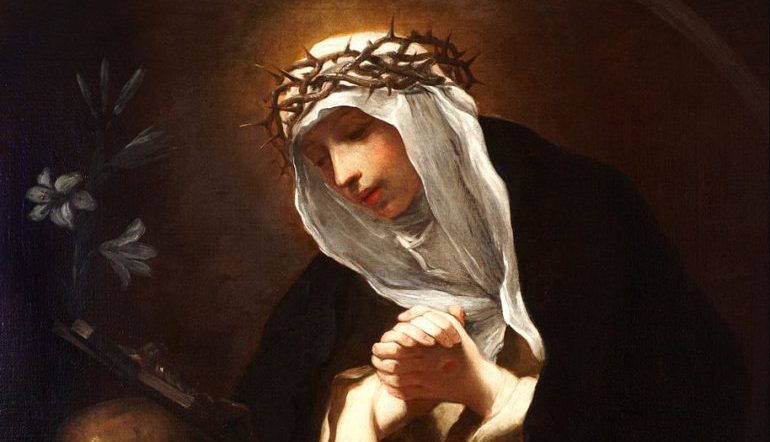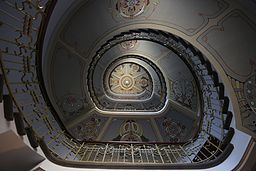Guest post by Carol Keeley
I grew up in small town in Michigan with thick-armed trees and noble Victorians, lush farm produce, a turn of the century Opera House. It’s leafy, kind, conservative, and typically Midwestern but for the blessed Adrian Dominicans–a tribe of women I sorely wish were running the world. They are lawyers, teachers, social workers, university presidents, doctors. There are philosophers and theologians, artists, therapists, and hospital administrators among them. One lawyer, also a pilot, was the first nun admitted to practice before the Supreme Court; their incoming prioress is the second. Many are exquisite musicians. They are, to a woman, fiercely smart and deeply spiritual. Of the eight kids in my family, most agree we’d be active Catholics still if the Church better reflected these women. And we go, thirstily, whenever we can attend Mass with the Adrian Dominicans. So to hear that they were being investigated by the Vatican was head-spinning.
Nineteen different U.S. women’s religious orders are being examined in what’s called an Apostolic Visitation. This news came as priests dominated headlines with more sex abuse scandals, which made the targeting of nuns even more baffling. As one exasperated Catholic wrote: “Is there a ‘Let’s See What We Can Do Next to Offend Everybody’ Committee at the Vatican?” Such investigations are seen as censorious. The only other
recent apostolic visitation was of a men’s order whose founder sexually abused young seminarians, misused funds and fathered a child. Pedophile priests were still being protected as the Vatican announced this investigation of women religious in the States. The timing alone tarred the nuns and sparked outrage. It’s a “disastrous PR move,” said Rev. Thomas Reese, a Jesuit priest who contends the Vatican has “a deep suspicion of U.S. nuns because they are educated, outspoken and don’t like to be pushed around.”
Explanations for the Visitation have been anemic and shape-shifting, centering on a “concern for their welfare.” But the cause was clearly stated in a paired investigation of the
Leadership Conference of Women Religious [LCWR], an umbrella group representing nearly 95 percent of U.S. women religious. A
splinter group was canonically approved in 1992, taking the name used pre-Vatican II, which sums up the schism. They wear habits and take direction from the Bishops. According to
Cardinal Levada, LCWR’s investigation is warranted because, despite being “warned eight years ago,” it has:
failed to “promote” the church’s teachings on three issues: the male-only priesthood, homosexuality, and the primacy of the Roman Catholic Church as the means to salvation.
Well,
that’s clear. The crime is that women religious have failed to prioritize the lauding of male priests, the persecution of gays and preaching damnation or Rome. Perhaps they’re distracted by attending to more immediate human suffering, like the dying or the poor. They have also been targeted because some nuns supported the health care bill and practiced
reiki. The Slovenian cardinal conducting the investigation of U.S. sisters, Franc Rodé, has stated concern for their “secularist mentality,” as well as “a certain ‘feminist’ spirit.” In an address widely believed to presage this interrogation, Rodé lamented the secularization of consecrated life and the “turmoil” since Vatican II. “In the last forty years, the Church has undergone one of her greatest crises of all times,” said the Cardinal, meaning not the sex abuse scandals but attempted liturgical renewal. “God blesses fidelity,” he stressed, “while he ‘opposes the proud.'”
I kept a lid on my reaction to all of this until the excommunication of the nun who heads a Catholic hospital in Arizona, where a young woman terminated an eleven-week old pregnancy after medical experts determined that she would have died otherwise. That morally agonized sister was immediately excommunicated, while not a single pedophile priest has been. This is the sort of injustice that drove me out of a Church I still mourn.
But I’ve no stomach for the Roman Curia and no part in this battle. American nuns don’t need me, anyway. They’re a wondrously formidable group. Take the
Adrian Dominican Sisters [ADS]: They’ve educated generations in Detroit, Chicago and beyond; they sponsor two universities, have backed down major corporations, tackled issues of food safety and the environment; they oversee four non-profit hospitals and a long-term care facility. The day before her first investigative interview, their prioress was in Iraq.
Maybe some of the independence that rankles Rome came over with this order’s foremothers: four cloistered nuns from a Bavarian convent sent to New York in 1853, to help German immigrant children. No one was there to meet them, so they sat on a dock until a priest tucked them in his dirt-floored basement–because they were cloistered–and had them deliver his meals upstairs via dumbwaiter. Within three years, they had a school up and running. By 1880, they sent sisters to two parishes in Adrian, Michigan; soon more arrived to help transform an old farm house into a hospital. In 1919, they launched the college that’s now
Siena Heights University. Meanwhile, they were staffing schools in Illinois, Ohio, New Mexico and Michigan, and nursing victims of tuberculosis.
The order attracted women who resembled their first mother general, Mother Camilla Madden: “strong, decisive and practical” women. They left close-knit, often poor immigrant farming families to join the Adrian Dominicans, get sterling educations, then go forth into lives they might never have had otherwise. Their adaptability, practicality and faith helped them thrive. During the Depression, despite often working without pay, the order always had a fund for the poor. Autonomy and improvisation were required, as communication and travel were difficult. Outgoing Prioress, Donna Markham, describes “a sense of freedom and responsibility, always grounded in contemplative prayer,” that marks the order from their earliest days to the present. In 1933, a newspaper wrote of the Adrian Dominicans: “The intellectual standard of the community is unsurpassed by any in the United States.” Their peerless teaching drew more candidates to their doors, “drawn to the Congregation by their naturalness, joyous outlook, and quick adjustment to conditions,” according to Seeds Scattered and Grown.
Among them was Sister Pat Hogan, who was taught by Adrian Dominicans while growing up in Chicago. Her Irish immigrant parents were thrilled when their only daughter joined the order in 1941. “I always thought this was a marvelous life,” Sr. Pat told me just before she passed suddenly. “I think it’s a shame more women don’t realize how wonderful it is, what opportunities it presents. If they only knew.” When she first joined, visits took place on Sundays. Her father “would take a notion,” as her mother put it, and board the train from Chicago to Adrian.
In those days we would come out of Mass walking in pairs, little sets of two coming out of the church quietly, heading up the sidewalk. It was pitch dark. And I would look up and see my father standing to the side, holding his hat, beaming at me. Oh! It would just make me so happy.
Later in those long Sundays, her father–a railroad worker who came to the States when he was seventeen–would sometimes fall asleep and wake to find Sr. Pat bent over his bare feet, lovingly washed, as she applied red nail polish. She giggled, recalling this as we drove between Adrian and Chicago. We spent hours on philosophy and theology as well as familial moments and pranks, fortified by stops for gas and chocolate bars. I still draw consolation from those long-ago conversations.
Years ago, I spent time at a Benedictine monastery with cloistered nuns, a combination of retreat and research for a novella. Some part of me still longs to live contemplatively. Solitude is natural for most writers; I find mine needs to be spirit-infused to keep it from becoming a house of mirrors or ego. I’d enjoyed the quiet company and mild curiosity of the sisters for several days. While in the kitchen washing dishes and chatting after dinner, I mentioned that there was a motherhouse in my hometown. Oh, what order? the nuns asked. “Dominicans,” I said. Oh, how nice. And what town are you from again, dear? “A small town in Michigan,” I said, and the entire kitchen halted. “You mean the Adrian Dominicans? You know the Adrian Dominicans?” They clustered closely around me now. “You realize they’re a very special order, don’t you? They’re unique. Everyone knows them.” For the rest of my stay, the nuns treated me with a respectful affection I hadn’t earned.
We didn’t realize how special they were until my father was tapped for the Board of Siena Heights. He was a prominent Catholic businessman who’d been involved in local public schools. When he joined the Board, “I thought it would be a bunch of little old ladies sitting around,” he says. “I’d known a lot of nuns.” Siena’s Board attracts luminaries. The chairman of Chrysler Financial, a national bank executive, several high-profile attorneys, a professor from the University of Michigan–all served with my father. He describes the start of one meeting. A petite Adrian Dominican shyly hands out her resume, saying she’s replacing someone. “I recognized her from some 12k race for a hospice organization. She was handing out water. You know, one of those keep-you-alive-until-the-next-corner people.” He stuffs the resume in his coat pocket and starts the meeting. “There was a money problem we weren’t sure how to handle. So one guy says one thing and another shoots it down, says something else. It’s getting more complicated by the second. Then we hear, ‘Excuse me. May I say something?’ We all turn and say, ‘Well sure, Sister.’ And in three sentences, she restates the problem and gives the solution. All the men cough and I say, ‘Great! That’ll work! Next item,’ while I’m wrestling her resume from my pocket. Turns out she worked for a Big Eight accounting firm. I’m telling you, Adrian Dominicans are experts in all walks of life. They’ll say a gorgeous prayer at the beginning of the meeting, then tear apart the balance sheet.” His respect for them is palpable. “The worst chewing out I ever got in my life came from an Adrian Dominican,” he chuckles with admiration, then sums up: “They’re the most intelligent, dedicated bunch of people I’ve ever met. Period. They could have run GM, but not as badly.”
My mother, a frustrated artist, married young and had a zoo of kids. After the last child left for college, my mother became a freshman at Siena, which has a vibrant art department. She was on the cusp of sixty. We witnessed her rebirth in the company of students, keen Siena faculty and these robustly creative and independent women, the Adrian Dominicans. She went on to have eight one-woman shows, including a retrospective just after her death at 75. Her time at Siena was transformational. Through our mother, we experienced another dimension of the Adrian sisters: their radiant faith.
While we were still shocked by news of our mother’s terminal lung cancer, the sisters rallied. Sr. Marcine wrote that “God is giving Denise time to say her good-byes,” an insight that pierced us with its wisdom, its reminder to open this as a gift, not to greet it with resistance. This is “a painfully sacred time in your life,” she wrote. I repeated this endlessly, like kirtan, through the searing weeks of our mother’s dying. The stream of thoughtful, unflinching, faith-filled letters from Adrian Dominicans lent us a graced strength we desperately needed.
Throughout that time, the sisters sustained us, both bodily and in prayer. After Mass they’d rush up, give us a squeeze and a studious look, one sister saying discreetly, “Do you need anything? We’re right here. We don’t want to intrude, but let us know. Anything you need. We’re praying for you.” Throughout it all, we were buoyed by just the thought of their prayers. The sisters have seen us through many hard chapters as a family. Their prayers draw awe. “I can feel them,” my mother kept whispering.
She faced her death with raw peace and courage, a testament of pure faith. The cancer had already spread when they found it. She refused any treatment. Her calm filled us all. But there were moments of fearfulness, like the day she was suddenly too weak to get out of the tub. Each morning’s bath had become more of a challenge, but it was a ritual she loved. So I climbed in with her and wrapped her arms around my neck, squatting. “We’ll stand up together, okay, Mum? I’ve got you.”
“I’m afraid,” she said in a tiny voice.
“Don’t be. God is with us. And the sisters are praying for you.”
“I can feel them,” she said happily and soon we were standing. And that’s how we did it each morning until she could no longer walk to the tub.
All eight of her children made it home to say those loving good-byes–galloping in from rural Italy, Paris, New York, Chicago, St. Louis–crowding around her bed and reciting prayers most hadn’t said for decades. My mother was French-Canadian, petite and tough. Hers was an Old World faith, devout and experiential, not intellectual. She appreciated the fine minds of the Adrian Dominicans, but it was their solar spirituality that drew her near. Toward the end, when she couldn’t leave the bed and barely had the strength to speak, she asked for Sr. Nadine.
A few hours later, the doorbell rang and I turned to see Sr. Nadine bustling in the front door, swarmed by my brothers and father. I soared back to my mother’s room and before I said a word, she whispered, smiling: “Nadine’s here.” A fierce, brilliant woman from a big Irish family, a former prioress and current historian, unsentimental, probably the only woman who intimidates my father–Nadine is a philosopher, a teacher, a force. My mother hadn’t asked to see anyone outside of the family, except Father Louis to get Last Rites. She was very private. We left the two women alone.
While carrying clean towels up to the linen closet later, I heard Sr. Nadine singing and paused. Nadine has a glorious voice. Through the cracked door, I saw she was cradling my mother. When I realized she was singing the Hail Mary, I fell to my knees, pressing tears to my palms. It was so beautiful, it burned me.
Sr. Nadine didn’t know our mother had asked for her. “Word here on campus was that she did not want visitors,” but she’d had an urge so came anyway. Later, at the door, with genuine bewilderment–as we all thanked her–Sr. Nadine said only, “Why me? Why would she ask for me? Any of the sisters would have come in an instant.” These women are truly communal. And they are guided by grace.
If Cardinal Rodé is right that God blesses fidelity and opposes the proud, then there’s no need to worry about the Adrian Dominicans. Pride is not a problem. They swat at direct praise as though it’s hornets. The sisters I’ve singled out will be more vexed with me than the many beloved sisters I feel miserable for not mentioning. These women live a consecrated life. They’re being assaulted by judgments dressed as definitions of what such a life looks like. I don’t care what they wear or how often they prostrate toward Rome. These women touch countless lives every day in sacral ways. Though we urged our parents to move after we’d scattered, they declined to leave the Adrian Dominicans. Our father still lives within their radius. How many American Catholics today have a spiritual family that binding?
The Apostolic Visitation will
cost roughly $1.1 million. “It’s a tragedy because nuns are the jewels of the system,”
said attorney Robert Bennett, who oversaw an investigation into clergy abuse. If nuns “had been listened to,” he said, some of that abuse “wouldn’t have happened.” Instead it appears to many that nuns are being scapegoated, used as deflectors, treated as a disobedient work force. Many priests have criticized the investigation and praised their sisters in faith. Bishop Gerald Wiesner defended the Adrian Dominicans specifically. “They live out their vows very ideally. They are exemplary,” he said, especially “their reaching out to the poor and social justice.”
What troubled our dying mother most wasn’t the ravaging cancer, but the fear that her children might not have the same consolation of faith she had. I’ve always identified with
Simone Weil‘s stance. She was a potent philosopher and social activist who died in 1943. Born Jewish, she had a long devotion to Catholicism, attending Mass with an ever-expanding sincerity and love, but resisted baptism, even on her deathbed, because “of the two little words
anathema sit.” She died as she’d lived, choosing to be with those who were suffering.
On my last car ride with Sr. Pat, we discussed Weil, changes in Church doctrine on purgatory, the many convulsions since Vatican II. “I just, I guess I have my own ideas,” she said apologetically, dropping the doctrinal. “I just have this sense that God’s mercy is so great. I think we can’t imagine the love, the forgiveness, the size of God’s mercy. I can just see it–God saying, ‘Because you gave a cup of water once in My name, Enter.’ I can’t imagine anyone being excluded from His love, what it would take. That love is too great.”
So much has come from four cloistered nuns who braved a journey to the New World. Maybe the dichotomy between consecrated life and mission is a false one. “My idea of mission is John’s Gospel,” says Sr. Nadine, quoting from John 17: “‘That they all may be one.’ The mission is to remove sources of division.” Maybe, as Pope John Paul II wrote in
Ut unum sint, “The Church must breathe with her two lungs.” East and West, traditional and contemporary, gay and straight, male and female.
This is Carol’s eleventh post for Get Behind the Plough.
Images from: http://commons.wikimedia.org/wiki/File:Wga_Pompeo_Batoni_Ecstasy_of_St_Catherine_of_Siena.jpg, http://www.adriandominicans.org/WhoWeAre/CongregationInformation/ForeMothers.aspx,http://www.adriandominicans.org/WhoWeAre/MotherhouseCampus/VirtualTour/MaddenHallGuardianAngels.aspx, http://www.flatlandersculpture.com/gallery/2006/sept_25_2006/denise_keeley.jpg, and http://www.sienaheights.edu/personal/pbarr/images/img_1257-East-Siena_LG.jpg



